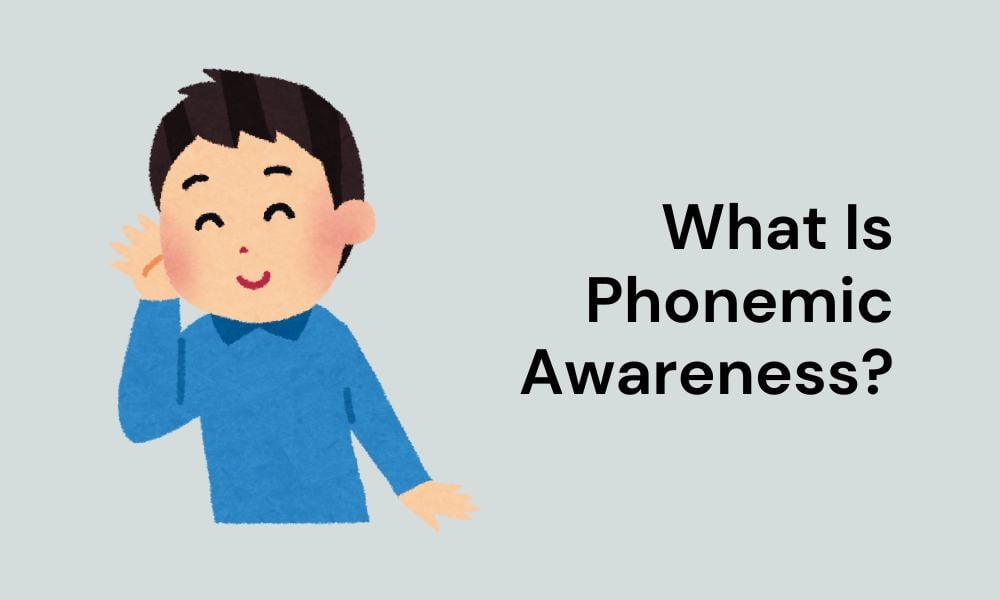
Phonemes are the smallest units of sound in spoken language. Phonemic awareness refers to the ability to focus on and manipulate phonemes in spoken words. English has 44 particular phonemes consisting of 24 consonants and 20 vowels.
Phonological vs. phonemic awareness
Phonological awareness refers to an individual’s awareness of a language’s phonological or sound structure. It is a listening skill that distinguishes speech units, such as rhyme and alliteration, syllables in words, and individual phonemes in syllables. Phonemic awareness is a subset of phonological awareness that focuses on recognizing and manipulating phonemes, the smallest sound units.
The following tasks are commonly used to assess children’s phonemic awareness or to improve their phonemic awareness through instruction and practice (Tønnessen & Uppstad, 2021):
- Phoneme isolation requires recognizing individual sounds in words, for example, ‘Tell me the first sound in paste.’ (/p/)
. - Phoneme identity requires recognizing the common sound in different words. For example, ‘Tell me the sound that is the same in bike, boy, and bell.’ (/b/)
. - Phoneme categorization requires recognizing the word with the odd sound in a sequence of three or four words, for example, ‘Which word does not belong? bus, bun, rug.’ (rug)
. - Phoneme blending requires listening to a sequence of separately spoken sounds and combining them to form a recognizable word. For example, ‘What word is /s/ /k/ /u/ /l/?’ (school)
. - Phoneme segmentation requires breaking a word into its sounds by tapping out or counting the sounds or by pronouncing and positioning a marker for each sound. For example, ‘How many phonemes are there in ship?’ (three: /š/ /I/ /p/)
. - Phoneme deletion requires recognizing what word remains when a specified phoneme is removed. For example, ‘What is smile without the /s/?’ (mile)
In other words, ‘phonemic awareness’ is made into a very broad concept. The demands placed on the ability to concentrate and to think abstractly are great.
Does phonemic awareness matter for reading?
The ability to segment and blend phonemes is said to be especially critical for the development of reading skills, including decoding and fluency, and even that it predicts reading ability (Taylor, 1998; Moustafa, 2001). Marilyn Jager Adams concluded that phonemic awareness is the “most important core and causal factor separating normal and disabled readers” (Adams, 1990, pp. 304-5).
Tønnessen and Uppstad (2021) argue that anyone who masters points 1-6 above is very likely to be good at decoding. However, once the level of the various skills mentioned in the six areas above reaches a certain point, improvements in those skills will presumably no longer entail corresponding improvements in decoding skill as measured in reading pace and number of mistakes.
To this, it should be added that there are very good readers who do not perform particularly well in those six areas. It can thus be questioned to what extent phonemic awareness is necessary for reading (Tønnessen & Uppstad, 2021).
Moustafa points out that a correlation — like the correlation between phonemic awareness and reading — does not establish causation. For example, a high correlation exists between being sick and being in a hospital. However, the hospital did not cause the illness. “In statistics, the word ‘predicts’ means nothing more than that there is a high correlation between two phenomena” (Moustafa, 2001, p. 248).
While the jury is still out, current thinking sees phonemic awareness as one of multiple deficits that are likely to interact to cause reading disability (Peterson & Pennington, 2012; Pennington, 2006).
